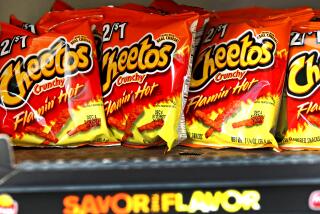If it’s in the house, parents will eat it
- Share via
Kids!
It’s not bad enough that they leave their clothes on the floor, cost you a fortune and drive you crazy with worry.
They also may be making you fat.
So says a study appearing in the Jan. 4 online edition of the Journal of the American Board of Family Medicine. Compared with adults living without children in the home, adults living with kids younger than 17, on average, take in an additional 4.9 grams of fat daily. And 1.7 grams of that additional fat is saturated fat -- the artery-clogging kind of fat that abounds in many meat and dairy products, processed foods and meals taken out from fast-food joints and eaten in restaurants.
The damage that children appear to wreak upon the diets of those who care for them piles up faster than the laundry. In a single week, the additional saturated fat intake of an adult living with kids amounts almost to that in an entire pepperoni pizza. And the litany of dietary offenses committed regularly by parents and guardians reads like a nutritionist’s nightmare: Adults who live with children, the study found, “had significantly higher odds of frequently eating pizza, cheese, beef, salty snacks, cakes and cookies, ice cream, bacon/sausage/processed meats and peanuts.”
To Stacey Gordon of Torrance, the difference is an inevitable fact of life with kids. A McDonald’s lies between her two daughters’ preschool and home, and she relents to their appeals at least once a week. Gordon, a full-time real estate agent in Los Angeles, says that each time she does so, it seems, she gives in to the urge to get a cheeseburger.
Before kids, Gordon says, macaroni and cheese, hot dogs and her daughters’ favorite cookies would never have been in her cabinets. Now, they’re not only a staple in her kitchen, they’re a quick and easy meal for her and the kids after a long day at work. “And I find myself making more cakes because they like them,” she says of her 3- and 5-year-old daughters. But each time she passes a tray of cupcakes, one seems to disappear down her throat. “They don’t last that long,” she says with a laugh.
The latest research is one of a raft of new studies that look at how family dynamics affect an individual’s propensity to become overweight. As the rate of child obesity has grown, researchers increasingly have focused on how parental influences -- genes, education, incomes, exercise and food choices -- are passed down to children. To save a child from obesity, this line of research suggests, one must first reform her parents’ diets.
The latest study, however, reverses that perspective, suggesting what the authors call “a reciprocal influence of children on adults.” In consumer studies, parents routinely cite their children as key drivers of snack food choice, home menu selection and restaurant visits. Perhaps, the authors suggest, the nation’s epidemic of overweight and obesity should be approached by looking at how children form their food preferences and how those preferences influence their parents’ decisions about what to buy and consume.
“Parents with children are likely to be susceptible in their food choices to both the marketing of convenience in food choices as well as indirectly to the marketing directed at their children,” wrote the study’s authors, Dr. Helena Laroche of the University of Iowa and Dr. Matthew Davis of the University of Michigan Health System.
Laroche and Davis combed through the responses of some 6,660 adults who were queried in a comprehensive survey of Americans’ health and nutrition conducted by the U.S. Department of Agriculture between 1988 and 1994.
They looked not only at a day’s worth of detailed food tracking recalled by respondents, but also at a separate survey that asked respondents how frequently they ate certain kinds of foods. This latter measure was where the high-saturated fat choices really stood out, Laroche said -- where parents and guardians fessed up to eating more pizza, ice cream, potato chips and salty snacks, sausage, cured meats and hamburgers than did adults without children in the home.
The study did not find differences in the total calories taken in on average by both groups. But compared with those who had kids at home, adults living without children took in more calories from leaner sources.
The difference between households with children living in them and those without, suggested Davis, seems to be that in households with kids, the high-fat food choices are more likely to come in the door, making their way from there into the mouths of adults in the household. First, it would seem, parents and guardians give in to their kids’ appeals for high-fat foods. And then, not surprisingly, they give into temptation.
“Kids can be very persuasive” in coaxing their parents and guardians into buying the fatty, sugary and salty foods that are overwhelmingly marketed to them, Davis says. “We’ve all been there. But as parents, we have to think twice about buying these foods for our kids,” he adds. “That they can make kids fat and start them down the road toward obesity is reason enough. They can also be very tempting for us as adults.”
Laroche and Davis emphasized that children are not to blame for the high-fat eating habits of the adults who care for them. But they suggested that physicians who treat adult patients should be as aware as pediatricians have become that poor food choices can be a family problem, not just a challenge for the individual patient. “It’s hard to disentangle what’s adults influencing kids and kids influencing adults,” Laroche says. “This is just a first step toward understanding that.”



